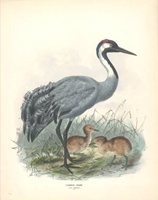
John Gerrard Keulemans (1842-1912) produced thousands of drawings and lithographic plates for over one hundred major bird books and ornithological journals. With his skill as an artist and lithographer, and his excellent observation as a naturalist, he will always remain one of the greatest ornithological illustrators. The compositions of many of his lithographs are given added personality when enhanced by female as well as male, their young, nests, habitat foliage, fruit and insects.
John Gerrard Keulemans (1842-1912), was trained in Rotterdam, in the family tradition of garment embroidery. Interested in natural history, particularly birds, like Gould Keulemans studied the taxidermy
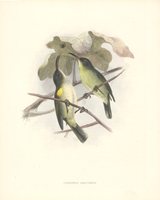
of birds before he developed his artistic skills. Keulemans lacked formal higher education, but the Director of the Rijksmuseum of Natural History at Leyden in Holland, Dr Hermann Schlegel, encouraged Keulemans in his study of anatomy and the scientific representation of birds. When 22 and supporting himself by providing birds and their feathers for millinery and the embellishment of the fabulous head attire of the period, Keulemans appealed to Dr Schlegel for more suitable work.
Schlegel recommended Keulemans for the position of scientific illustrator on German biologist, W.L.H. Dohrn's expedition to West Africa. After exploring
areas from their base, Keulemans travelled further afield with an African native guide, Keulemans
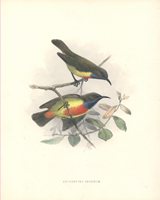
recorded birds they found, and gathered botanical specimens for accurate illustration of habitat. After repeated bouts of fever in 1866 John Gerrard returned to Europe. In the
Dutch Journal of Zoology Keulemans published an article on 64 bird species identified by Dohrn and himself. Zoologists have acknowledged Keulemans’ precise scientific documentation of bird-life in Africa.
Told of Keulemans’ fine illustrations by their mutual friend Dr Schlegel, in 1868 the young librarian at the Royal Zoological Society in London, Richard Bowdler Sharp, commissioned Keulemans to draw and lithograph 120 hand-coloured illustrations for his
Monograph of the Alcedinidae or Family of 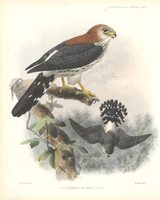 Kingfishers
Kingfishers.
The study of biological sciences was becomingly increasingly popular in England. Aristocratic enthusiasts, various museums and the Zoological Society sought specimens from all over the world to add to their collections - and required illustrations. London with its important Zoological Society had established itself as the centre for ornithological publications. John Gould, known as 'the bird man' was hugely responsible for this interest.
Despite confining his illustrations almost completely to ornithology after his move to London, Keulemans managed to support himself by regular employment as a bird illustrator for the
Proceedings and Transactions of the 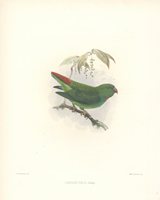 Zoological Society
Zoological Society and another prominent journal,
The Ibis, published by the British Ornithological Union. His work was of high quality, usually finer in style and composition than the illustrations of many of his contemporaries. His lithographs are usually distinguishable by the inclusion of his monogram JGK on the lithographic plates. When Buller’s
Birds of New Zealand was published in 1871, Keulemans' lithographic plates were described in The Times as “absolutely perfect”. George Rowley's
Ornithological Miscellany, c1876-1878, included bird species from many countries, farming and hunting, new birds and ancient fossils - and included 127 hand-coloured lithographs, mostly by Keulemans.
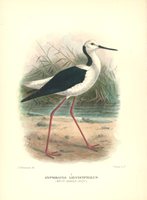
Keulemans was probably the most popular ornithological illustrator of his day, but work for an artist lithographer decreased as technology advanced. With the necessity of supporting some of his ten surviving children as well as himself, Keulemans continued working and moved to a smaller dwelling. As they grew older and became talented artists themselves, his daughters often assisted by colouring their father’s lithographs. He usually coloured the first lithograph and then closely supervised any assistants.
Keulemans’ 163 beautiful hand-coloured lithographic plates for Mathews’
Birds of Australia c1910-1927, were among his finest work. By utilizing hand-coloured lithographic illustrations for his
Birds of Australia, Gregory Mathews
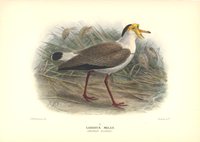
published one of the last works to be illustrated by this finely detailed, slower, more expensive process. Keulemans’ lithographs are rarely seen today. His lithographs of Australian birds are among the most beautiful and most important of the early Australian ornithological works - including, as they did, many newly discovered birds.
The British Birds Rarity Committee obituary, written by Gregory M. Mathews said “… few realized the individuality of the unassuming artist, or recognized that for thirty years he was the unrivalled and unequalled draughtsman of ornithological subjects. From 1870 to 1900, scarcely any ornithologicial work of importance was completed without “illustrations by Keulemans” and his sureness of design combined with a felicity of expression, made his beautiful figures always a delight to refer to.”
To find Keulemans' lithographs on this AntiquePrintClub website, type Keulemans in Search bar.